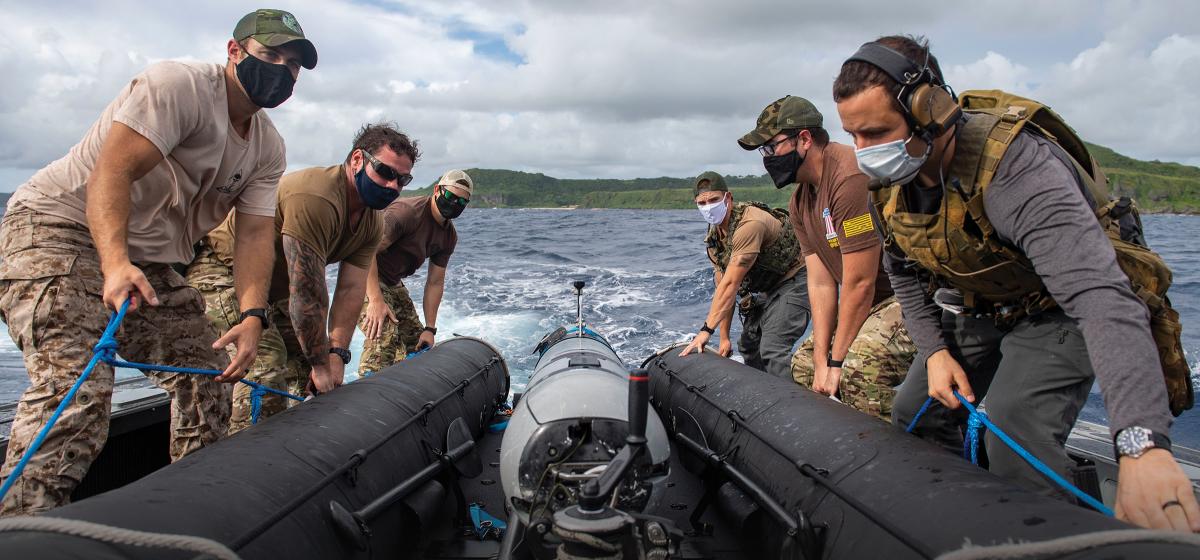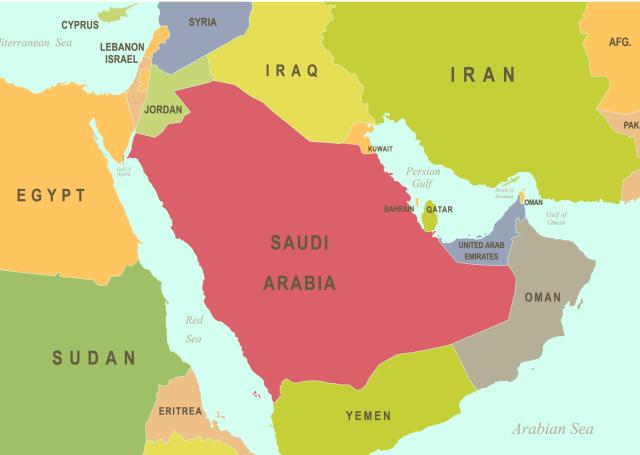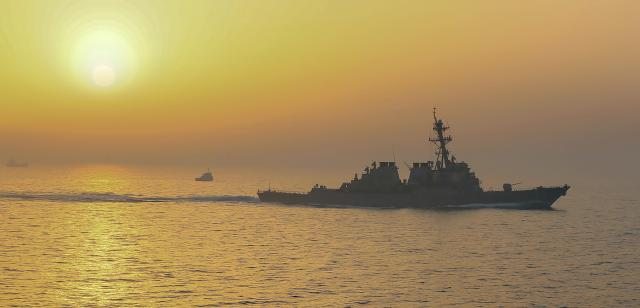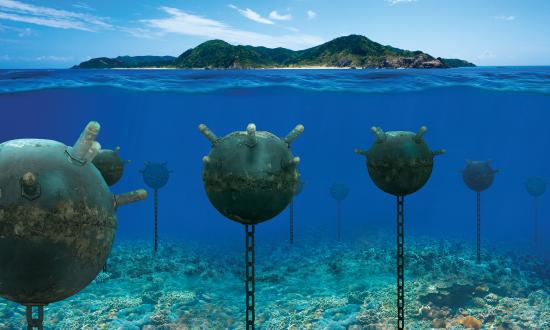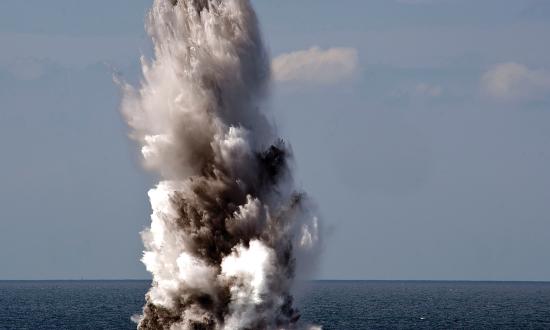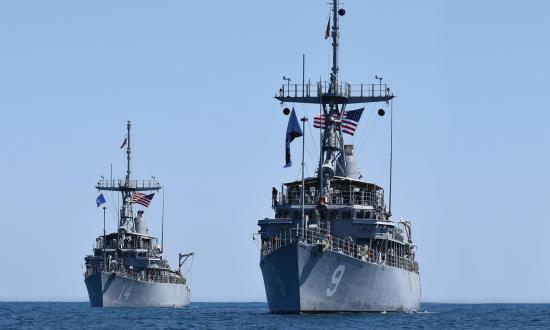A single mine laid in the Strait of Hormuz could shut down 20 percent of the world’s oil supply, decimate the global economy, and upend the stability of the Middle East at large.1 In addition, more U.S. vessels have been mission-killed by mines in the past three decades than by any other method. With an estimated 6,500 mines in Iran’s inventory, this threat is as present today as it was when the USS Tripoli (LPH-10), Princeton (CG-59), and Samuel B. Roberts (FFG-58) were taken out of the fight during the Tanker and Gulf wars.2
This asymmetric capability allows adversaries, namely, Iran, to define the battlefield and the terms of the fight. Nevertheless, the threat remains largely unmitigated and is notably missing from the surface warfare officer training and planning continuum. This is an advantage they do not enjoy on any other front. Only four rapidly aging minesweepers are stationed in the Fifth Fleet area of operations, and they are vulnerable to attacks from both small fast inshore attack craft and Iran’s advanced coastal-defense cruise missiles.
The littoral combat ship (LCS) program has been presented as a solution to the littoral challenges facing the Navy. A mine warfare package is in active development. The mine warfare module, however, has seen its budget cut by 77 percent and is not yet online, meaning that in the short to midterm, LCS will not be able to cover this critical mission area.3 Furthermore, the Navy has failed to make concerted efforts to train on point-defense techniques specific to minesweeping operations. While these tactics exist on paper, they have not been drilled in the conventional surface navy with the emphasis of other less threatening mission areas.
The pairing of Aegis air- and missile-defense capabilities with minesweeping assets is critical to securing national interests in the Middle East. Mine warfare will be at the forefront of Iranian strategy should it enter a conflict with the United States; thus, countermine warfare should be part of surface warfare officer (SWO) and unit-level training, not an afterthought in the Basic Division Officer Course (BDOC) or a forgotten mission area left to the 11 aging minesweepers. Once the knowledge has been solidified in the fleet, Navy leaders should ensure units are pre-staged and provided with mine warfare assets that will prove critical to victory.
Training for Reality
There is a concerning lack of training given to the average SWO on minesweeper capabilities, mine countermeasures, and the required conventional assets to support minesweepers in a real mine-threat environment. The combat information center watch officer curriculum covers a mere five topics related to mine warfare, and an officer will be expected to understand only four more topics related to mine warfare during officer-of-the-deck qualification. This is the totality of the mine warfare training an officer receives while working toward his or her SWO pin, which signifies warfighting proficiency in the surface warfare community. By no longer detailing first-tour division officers to minesweepers and relegating mine warfare to a single PowerPoint presentation in BDOC, Navy leaders have implicitly communicated that mine warfare experience is not valued or needed, as no alternate means for gaining proficiency has been provided. That must change.
Despite laudable efforts by the Surface and Mine Warfare Development Center, fleet commanders, and Carrier Strike Groups (CSGs) 4 and 15, there remains a gap in the curricula of composite training unit exercises (COMPTUEXs) and surface warfare advanced tactical training. CSGs 4 and 15 are responsible for training and assessing the CSGs slated to deploy overseas. To adequately prepare sailors, CSGs 4 and 15 must train and assess conventional ships on their ability to operate in a mine environment. For this training to be realistic, it must incorporate minesweeper squadrons into COMPTUEX, require simulated high-value unit (HVU) defense in mine-threat environments, and provide training opportunities for conventional SWOs to use and understand the Mine Warfare Environmental Decision Aid Library (MEDAL)program, along with other mine countermeasures.
The Navy must revise its training curricula and programs to reflect the near certainty of mine threats in war. Mine warfare must be a continual topic of training during the predeployment workup cycle and receive as much emphasis as antisubmarine warfare, surface warfare, and antiair warfare, which have weeklong seminars and graded assessments. The capstone of the mine warfare training and discussion should be a graded event during COMPTUEX in which, at some point in the monthlong predeployment wargame, a simulated or actual chokepoint should become a “minefield,” cutting the force in half. This scenario would work perfectly off the coast of San Diego, where minesweepers can be placed on a tether and get underway with an escalation in the scenario during COMPTUEX, as directed by the carrier strike group mine warfare commander (Foxtrot).
In such a scenario, the expected coordination at the strike-group level would require a robust understanding of what would be needed to overcome a minefield. Problems that would need to be addressed are: (1) What type of mine needs clearing? (2) What is the bottom type and depth? (3) How many Seafox C rounds (semiautonomous one-shot mine identification and disposal vehicles) does the force have, and are there enough to meet the expected number of mines? (4) Is a sweep needed? (5) How long will the minesweeper require to get on station? (6) Can it effectively remain on station in the mine threat area?
This proficiency should be gauged by another graded evolution in which an air-defense unit provides continuous HVU defense while maintaining station within three nautical miles of the minesweeper and while ensuring it avoids the uncleared mine threat area. This varsity-level evolution would require discussion and planning like what would be expected in a real-life scenario, and most likely would lead to the realization that current minesweeping assets generally are too far removed from the fight to effectively combat the threat. This will show that if a CSG is tasked to execute the mine warfare mission, Aegis platforms must play a more active role. This will require pre-staging of countermine assets.
Pre-staging for Victory
The enemy will dictate where the next mine threat area will be, and they likely will pre-stage forces and align coastal-defense cruise missile sites to own the battlespace. In an age of asymmetric warfare, particularly in Fifth Fleet, Iran could easily overwhelm underprepared and outdated U.S. mine countermeasure capabilities, as Iran likely can mine the Strait of Hormuz in less than 24 hours.
The four minesweepers stationed in Bahrain, unless they are already under way in the vicinity of the threat, would require at least 30 hours to transit to the mine-threat area at top speed. Further, once a minesweeper is on station, it will require HVU defense, as it cannot provide organic defense. Complicating matters, an Aegis platform would require a standoff distance outside the mine-threat area while providing HVU defense, limiting its effectiveness in covering the minesweeper. This is particularly true in the Strait of Hormuz, where the threat axis would not allow an Aegis ship optimal positioning.
Aegis ships must be trained and ready for the dangerous and slow task of remaining on station in support of minesweepers in a mine threat area. But what about when the minesweepers cannot make it, because of combat losses or other circumstances? One option is to leverage the speed of Aegis platforms and forward-staging capability. Fully capable of more than 25 mission areas, an Aegis ship is a powerful asset in all theaters, yet, it rarely is employed in any minesweeping or mine hunting training scenarios or operations. To overcome the hesitation to employ a cruiser or destroyer in a low-attention warfare area such as mine warfare will require a paradigm shift.
Commanders must recognize the implications of mines in critical chokepoints and use existing assets to meet this task. This does not mean the Navy should designate a destroyer in each strike group as a minesweeper—the threat is too infrequent for such a response. Rather, the service needs a pre-staged mine warfare package ready to be flown out and integrated into a destroyer’s infrastructure. A contingent of explosive ordnance disposal personnel, meteorology and oceanography officers, and minemen to employ unmanned autonomous vehicles is an ideal solution.
Flight I destroyers, particularly non-ballistic-missile assets, are well suited for this task. With only minor modifications, these vessels have the capability to conduct such a mission now. Their boat davit can launch the unmanned vehicles, which can be embarked and staged amidships, on the forecastle, or in the torpedo magazine. The telemetry hardware on board Aegis ships typically is only used for test missile shots; however, it can provide the communication path for unmanned mine warfare vehicles. The ships’ combat information center (CIC) annexes are used for various inorganic cells or embarked staffs. This compartment can provide the hardware, computers, and space for the embarked mine response team.
Embarked mine warfare watchstanders at spare consoles and a computer-aided dead-reckoning table in CIC will integrate the embarked team into the ship’s established combat team. This will provide the tactical action officer the required inputs to operate in a mine threat area, employing unmanned vehicles in an optimal position. The sonar suite can use the MEDAL and verify environmental readings for expected and realized ranges real-time.
In mine warfare, rapid employment is critical, and having an asset in theater with speed and robust self-defense capabilities configured for this threat is the real solution. Having this package staged to deploy on short notice, but only used when needed, is the most efficient course of action. Staging the teams and equipment in Bahrain to combat threats in the Fifth Fleet area of operations will keep the assets close enough to the fight to be deployed effectively. Once staged, the teams would have a spectrum of tethers proportional to the likelihood of their employment. Tethers would include, from least to most restrictive: (1) normal operations, in which regular maintenance, liberty, and training are allowed; (2) a 48-hour tether to deploy; (3) a 24-hour tether, with aircraft assigned on alert posture for transport; and (4) staged for employment on board the designated platform with personnel embarked.
The Navy must accept the hard truth that its minesweepers are old and slow, and their lesser capabilities hinder their effectiveness, whether through limited speed, weak self-defense capabilities, or widespread maintenance issues. The life expectancy of the minesweeper fleet has been extended well past its limits, and the crews’ efforts to keep these ships in the fight have been herculean. Despite promising mine packages in development, LCSs will not be ready to shoulder this mission anytime soon. Developing the training and infrastructure in the surface navy according to the following path will better guarantee success:
1. Establish a baseline of mine warfare knowledge in the officer corps through renewed emphasis in BDOC and during the SWO qualification process.
2. During the basic and advanced training phases, provide crews with difficult and realistic training on how to fight in a mine warfare environment and how to support minesweeping/hunting efforts.
3. Develop infrastructure and training to embark mine warfare teams on board Aegis platforms.
4. Pre-stage rapid-response mine teams and assets in Bahrain, ready to embark ships in CSGs on short notice.
These suggestions would be relatively inexpensive, yet, they would pay dividends in the likely case that the enemy exploits this asymmetric capability. Allowing the threat to remain largely unmitigated and potentially paying with the lives of sailors and Marines is not acceptable. The Navy must act decisively now on the training, infrastructure, and personnel fronts to prevent unnecessary losses. The force must decide if it will pay the small price and shift the paradigm now or risk paying dearly in combat.
1. Christopher Woody, “The US Navy Faces ‘A Huge Liability’ in Countering One of Iran’s Favorite and Most Dangerous Weapons,” Business Insider, 16 August 2018; “The Strait of Hormuz Is the World’s Most Important Oil Transit Chokepoint,” U.S. Energy Information Administration, 20 June 2019.
2. Anthony Cordesman et al., “US-Iranian Competition: The Gulf Military Balance,” The Center for Strategic International Studies, 6 January 2013; “Mines Hit USS Tripoli and the USS Princeton,” United Press International, 18 February 1991; Bradley Peniston, “The Day Frigate Samuel B. Roberts Was Mined,” USNI News, 22 May 2015.
3. David Larter, “Congress Slashes Funding for the Navy’s LCS Sensors—Again,” Defense News, 19 December 2019.



